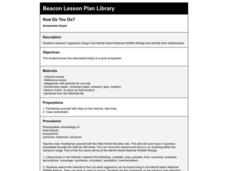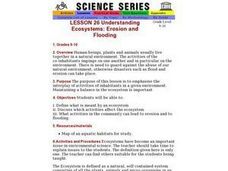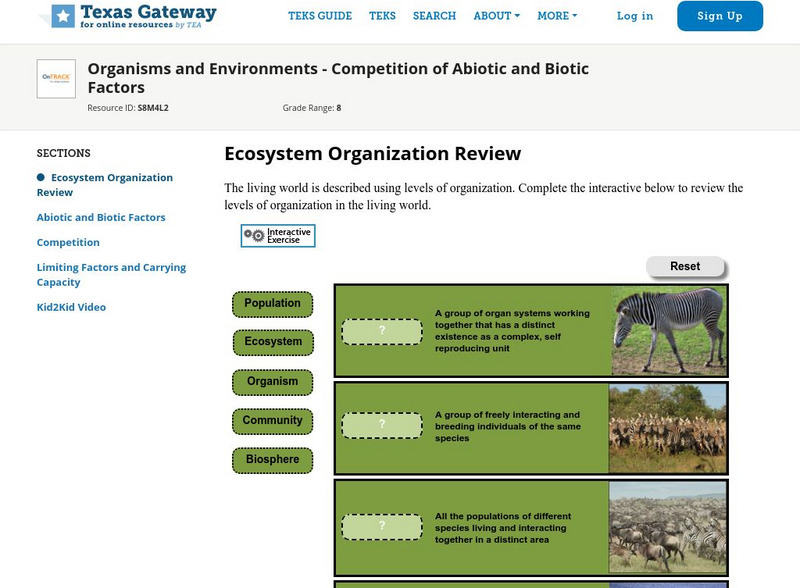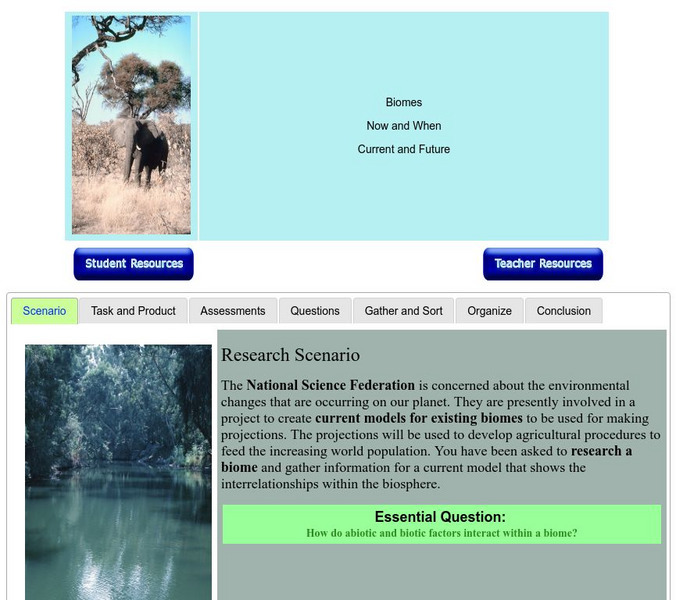Curated OER
The Portable Niche
Third graders, in groups, research animals, plants, and conditions found in ecosystems.
Curated OER
How Do You Do?
Seventh graders research organisms in the Merritt Island National Wildlife Refuge. They create a picture book demonstrating their understanding of relationships.
Curated OER
Survivor
Seventh graders investigate changes in the ecosystem within the school year. They see that ecosystems, communities, populations, and organisms are dynamic and change over time. They, in groups, collect data in quadrants in the fall,...
Curated OER
Understanding Ecosystems: Erosion and Flooding
Students study the balance in the environment needed for ecosystems. They discuss what can lead to erosion and flooding.
Curated OER
Earthworm Movement and Landscape Structure
Students describe differences in animal usage of habitats depending upon successional status of site. They also design other experiments to test movement patterns of animals through habitats of differing structure.
Curated OER
Make Sense of Nature
Students participate in this program that heightens their awareness and curiosity of nature as well as their sense of adventure and exploring new surroundings. They identify and choose an object from nature after exploring it with other...
Curated OER
Science Word Search
In this literacy worksheet, middle schoolers find the words that are related to the concepts that are the theme of the word search. New vocabulary is the focus of the puzzle.
Texas Education Agency
Texas Gateway: Competition of Abiotic and Biotic Factors
This tutorial explores abiotic and biotic factors with videos and interactive activities.
McGraw Hill
Mc Graw Hill Ryerson: Abiotic and Biotic Environments
Take this ten question quiz on abiotic and biotic environments. The quiz is multiple choice.
Encyclopedia of Earth
Encyclopedia of Earth: Ecology: Abiotic Factor
Explains what an abiotic factor is, and discusses each of six types and their roles in ecosystems and habitats. (Published: July 31, 2010)
Other
Baltimore County Public Schools: Biomes: Now and When (Online Research Model)
Biomes lesson designed to answer the question, how do abiotic and biotic factors interact within a biome? integrates biological concepts with literacy knowledge and skills. Includes directed questions, assessment guides, project...
Oswego City School District
Regents Exam Prep Center: Biotic vs. Abiotic
This NY Regents prep site provides a nice overview of what abiotic and biotic factors of an ecosystem are, as well as a brief description of carrying capacity.
National Geographic
National Geographic: Ocean Abiotic Factors
After looking at examples of biotic and abiotic factors in ecosystems, students focus on abiotic factors in marine ecosystems, the physical processes that are involved, and the impact human activities can have on these. Includes handouts...
Utah Education Network
Uen: Lesson Plan: Biotic and Abiotic Factors
This site provides a detailed lesson plan to help students grasp the concepts of biotic and abiotic. Background information is provided for the teacher and plans are given for two days.
Other
Abiotic Factors
Abiotic components are the nonliving components of the biosphere. Chemical and geological factors, such as rocks and minerals, and physical factors, such as temperature and weather, are referred to as abiotic components.
Texas Education Agency
Texas Gateway: Abiotic and Biotic Factors in an Ecosystem
Do you know the difference between abiotic and biotic factors? This tutorial explores both these factors and their importance in the ecosystem.
Sophia Learning
Sophia: Abiotic and Biotic Factors: Lesson 2
This lesson will introduce abiotic and biotic factors, giving examples and comparing/contrasting the two. It is 2 of 4 in the series titled "Abiotic and Biotic Factors."
SMART Technologies
Smart: Energy Flow in an Ecosystem
Students learn about Abiotic and Biotic Factors and how they affect the ecosystem in which an animal might live in.
That Quiz
That Quiz: Biotic or Abiotic? Living or Non Living?
This fun quiz has you choose between different images to decide whether it is biotic or abiotic. It also gives examples through illustrations of abiotic and biotic things.
Other
University of the Western Cape: Department of Biodiversity: Abiotic Components
The Department of Biodiversity at UWC presents the impact different abiotic components on plants and animals. Some factors are light, temperature, and wind.
Concord Consortium
Concord Consortium: The Effect of Environmental Factors on the Growth of Plants
How do environmental factors affect the growth, development, and health of organisms? Students explore the effect of environmental factors on traits by investigating factors that affect the growth of plants.
McGraw Hill
Glencoe Online: Abiotic Factors
Take this 8 question check quiz on abiotic factors. The quiz is multiple choice.
CPALMS
Florida State University Cpalms: Florida Students: Diving the Depths of Underwater Life
A tutorial that explores how and why the distribution of aquatic life is affected by abiotic factors, such as light, temperature, and salinity.
Climate Literacy
Clean: Temperature and Precipitation as Limiting Factors in Ecosystems
Students correlate graphs of vegetation vigor with those of temperature and precipitation data for four diverse ecosystems, ranging from those near the equator to the poles, to determine which climatic factor is limiting growth.
Other popular searches
- Biotic Abiotic
- Biotic and Abiotic Factors
- Biotic and Abiotic
- Abiotic Biotic Environment
- Abiotic and Biotic Elements
- Abiotic and Biotic Resources
- Biotic Abiotic Factors
- Abiotic Biotic Lab
- Ecosystems Abiotic Biotic
- Biotic Abiotic Pictures
- Biotic Abiotic Piotures
- Biotic or Abiotic Changes























